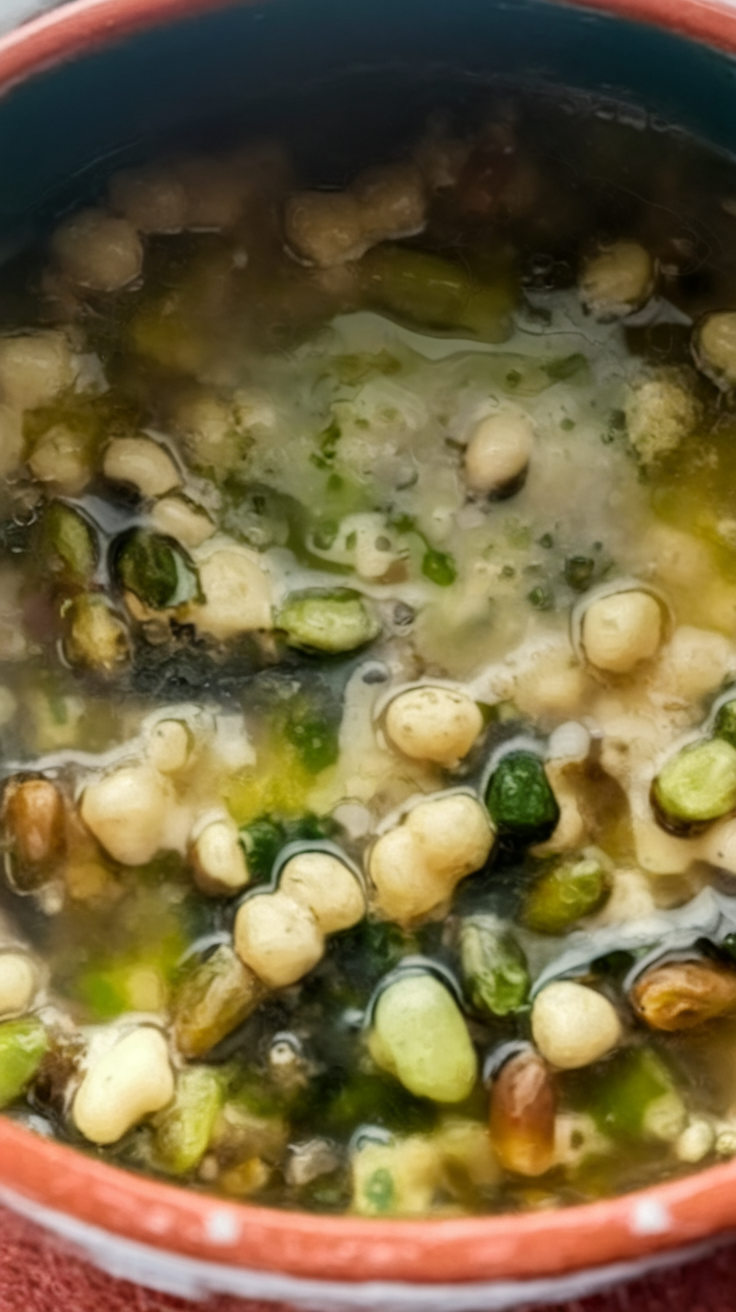Ah, hominy—those plump, chewy kernels of maize that feel like a comforting hug on a cold day. There’s something about the way they absorb flavors, much like a sponge soaking up history. As I stir the pot, I can’t help but think of my grandmother’s stories, her voice a melody in the background as aromas swirl like leaves in a gentle breeze.
Steps
- Warm the olive oil in a large pot over medium-high heat. Add the chopped garlic, onion, and celery, and cook for 10 to 15 minutes, stirring occasionally, until the vegetables become translucent and tender.
- Incorporate the drained hominy, beans, poblano, and green pepper into the pot. Add the toasted cumin seeds and ground coriander, stirring to thoroughly coat the ingredients.
- Once the mixture begins to boil, pour in 2 cups of vegetable broth and stir. Cook for 8 to 10 minutes with occasional stirring, then cover the pot, reduce the heat to low, and let it simmer for an hour.
- After simmering, check the consistency; if it’s too thick, gradually add the remaining broth until it reaches your desired texture. The hominy and beans should be tender and have absorbed much of the broth.
- To serve, reheat the stew over medium-high heat. Mix in the chopped spinach, watercress, or chard, and cilantro, allowing the greens to wilt into the stew within a minute or so. Adjust the seasoning with sea salt to taste.

Ingredients
- 1 tablespoon olive oil
- 3 cloves garlic, chopped
- 1 onion, chopped (about 1 cup)
- 2 stalks celery, chopped (about 3/4 cup)
- 4 cups cooked hominy, drained, or 2 15-ounce cans prepared hominy, rinsed and drained
- 2 cups cooked white, pink, or pinto beans, or 1 15-ounce can of white, pink, or pinto beans, rinsed and drained
- 2 poblano peppers, roasted, cooled, seeded, and chopped
- 1 mild green pepper, roasted, cooled, seeded, and chopped
- 1 teaspoon cumin seeds, toasted
- 1 teaspoon ground coriander
- 2 to 3 cups vegetable broth
- Sea salt, to taste
- 4 cups of spinach, watercress, or chard, chopped
- 1/2 cup cilantro, chopped
FAQ
- What is hominy and how is it prepared?
- Hominy is dried corn that has undergone a process called nixtamalization, where it is soaked in lye or lime to remove its tough outer hull. This results in plump, tender kernels that enhance the flavor of dishes like the Hominy, Bean, and Green Chili Stew.
- What are the ‘Magic 8’ indigenous foods mentioned in the article?
- The ‘Magic 8’ refers to corn, chilies, potatoes, beans, squash, tomatoes, vanilla, and cacao. These foods are foundational to many cuisines around the world and were originally cultivated by Native Americans.
- How does the ‘Three Sisters’ method of planting benefit crops?
- The ‘Three Sisters’ refers to the planting of corn, beans, and squash together. The corn provides support for the bean vines, beans enhance soil fertility by fixing nitrogen, and squash leaves offer ground cover to reduce weeds and retain soil moisture, creating a mutually beneficial growing environment.
- What is the significance of using heirloom beans and white hominy in the stew?
- Using heirloom beans and white hominy adds authenticity and depth of flavor to the stew. These ingredients are celebrated for their rich history and connection to Native American culinary traditions.
- How can I adjust the consistency of the Hominy, Bean, and Green Chili Stew?
- If the stew appears too thick, you can gradually add more vegetable broth until you reach your desired consistency. This allows for customization based on personal preference.
Tips
- Roast the Peppers: Before adding them to the stew, make sure to roast and seed the poblano and mild green peppers. This will enhance their flavor and give a smoky depth to your stew.
- Toast the Spices: Take a moment to toast the cumin seeds before using them. This step will release their essential oils and boost the overall flavor of your dish.
- Adjust the Broth Consistency: If you find the stew too thick, gradually add more broth until you achieve your desired consistency. The hominy and beans will absorb liquid, so it’s crucial to find a balance that suits your taste.
- Incorporate Greens Just Before Serving: Add spinach, watercress, or chard at the end of cooking. This ensures they retain their vibrant color and fresh taste, wilting just enough from the heat of the stew.
Equipment
- Large Soup Pot – Essential for cooking the stew.
- Roasting Pan or Baking Sheet – For roasting the poblano and mild green peppers.
- Blender or Food Processor – Useful if you decide to puree any ingredients for a smoother consistency. (Not explicitly mentioned but can be handy for certain texture preferences.)
- Citrus Juicer (optional) – If you plan to use fresh lime juice for flavor enhancement.

